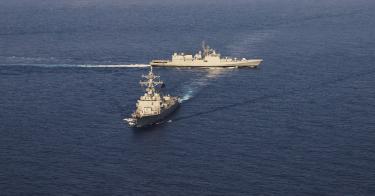The U.S. Navy’s long-range plan for warship construction, released last week, is remarkable for all the wrong reasons. Once again, the Biden administration’s lack of threat awareness is on full display. Even as Russia rampages in Ukraine and China rattles sabers in Asia, the administration seeks to underfund the nation’s defenses.
The administration’s cognitive dissonance has given Americans much to worry about, from border insecurity to resurgent terrorist regimes in Iran and Afghanistan. However, it’s Vladimir Putin’s invasion of Ukraine that has awakened many to the dangers of the world today and the realization that showing weakness only invites aggression.
That danger is ever-present in East Asia, where Chinese leaders are readying to take over Taiwan this decade. Such a war would put the estimated 80,000 Americans living in Taiwan at risk.
A strong U.S. Navy has kept China’s ambition to conquer Taiwan in check for decades. But President Joe Biden’s shipbuilding plan would leave the United States with the smallest navy in over 100 years, even as China continues the rapid expansion and modernization of its fleet—already the largest in the world. How can Biden expect a smaller U.S. fleet to sustain deterrence through this decade and beyond?
>>> Is Joe Biden’s New U.S. Navy Budget Illegal?
The Navy’s long-range shipbuilding plan admits the need for a stronger fleet: “The new era of strategic competition requires a larger, modernized, capable, globally deployed, forward, and lethal multi-domain Navy.” It then blithely proceeds to go in the exact opposite direction, shrinking the Navy from today’s 297 warships to only 280 by 2027. By contrast, the previous long-range plan would have grown the Navy to 322 warships by 2027.
That date is critical. In March 2021, Admiral Philip Davidson, who as commander of the U.S. Indo-Pacific Command was responsible for prosecuting any war in Asia, testified that China was making every preparation for a military takeover of Taiwan by 2027. The date was later seconded by Davidson’s successor, Admiral John Aquilino, and Mike Pompeo, a former director of the CIA and secretary of state.
So why is the administration not taking the danger seriously?
One reason could be that defense spending is not a top priority for the Biden administration, whose main defense interests seem to be pursuing social equity, reducing carbon emissions, and tracking down phantom extremists in the ranks.
Faced with far more pressing threats (such as the war in Ukraine), the administration should be focusing on how to ensure the nation has the defenses needed to deter and, if needed, repel aggression. Yet, Biden’s Interim National Security Strategic Guidance and his unclassified fact sheet of the National Defense Strategy make scant mention of growing U.S. defenses. The latter only meekly commits to “develop, design, and managing forces.”
Another glaring omission is leadership. The shipbuilding plan cuts ship numbers this decade when the need is greatest. Then, rather than present a clear recommendation for the type of fleet Congress should fund, it offers options. This smacks of buck-passing, and Congress must get to the bottom of it. Congress could start by insisting that Biden name an assistant secretary of the Navy for Research, Development and Acquisition—the person who would be responsible for implementing the shipbuilding plan.
>>> The U.S.–Japan Security Alliance Must Act Now to Deter China from Attacking Taiwan
Lastly, it is important to realize that competent sailors and officers cannot be trained overnight. It requires years of at-sea experience on fleet ships. Yet the administration’s plan would throw too many ships into early retirement. Mothballing ships with plenty of life left deprives the Navy of sailors and officers it will need in the future. This will only erode the Navy’s ability to grow and sustain a warfighting posture for a conflict that appears to be fast approaching.
The plan aims to take the immediate savings gained from retiring ships early and redirect those funds toward the development of future weapons and technology. The “divest to invest” funding strategy shrinks Navy capacity up-front and counts on new “wonder weapons” still on the drawing board to pay off sometime in the future. Even if the gamble does pan out, it will leave the Navy with fewer ships on which to train future crews. Far better to keep ships on active duty, training and sustaining capacity, until viable replacements are on hand.
Russia is actively waging war, and China poses a danger unlike any the United States has ever faced. These are inconvenient truths, but these threats must be taken seriously, not dismissed by wishful thinking.
This piece originally appeared in the National Interest https://nationalinterest.org/blog/buzz/navy%E2%80%99s-latest-shipbuilding-plan-may-sink-america%E2%80%99s-pacific-ambitions-202095





